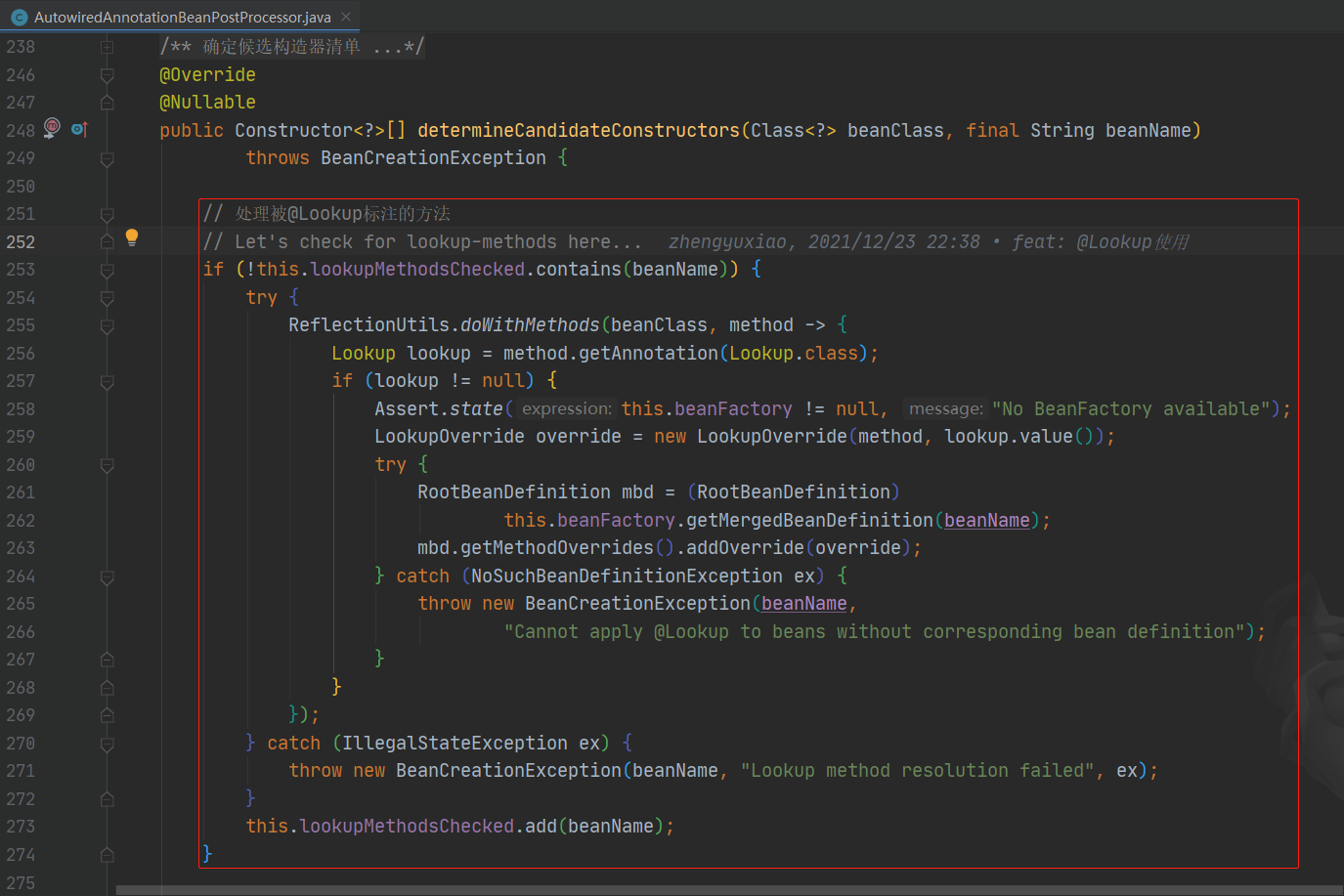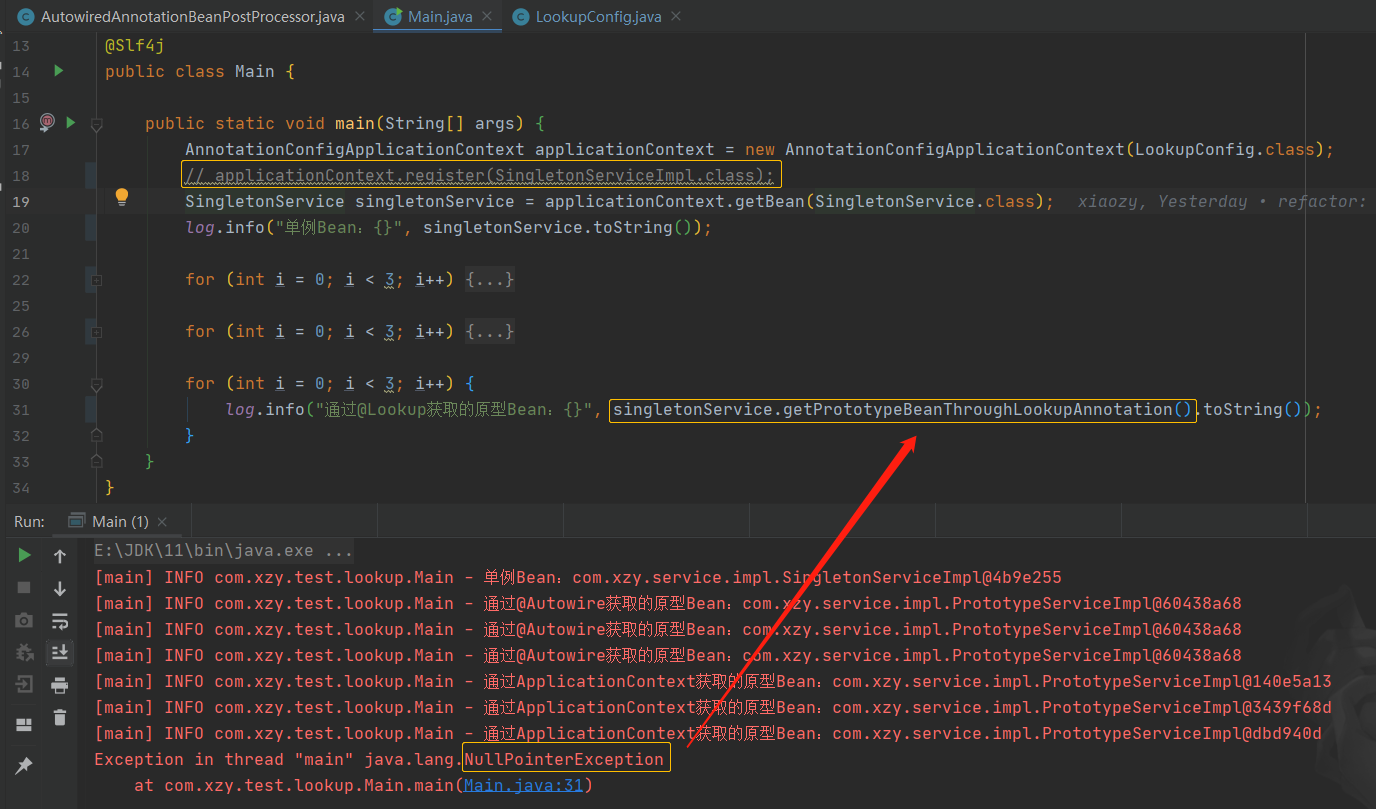Spring依赖注入之@Lookup注解
在了解Spring构造器推断时看到了下列源码:

问题分析
一般我们会使用@Autowired注解来实现依赖的自动注入:
-
属性注入
@Component public class Xxx{ @Autowired private Aaa aaa; } -
构造器注入
@Component public class Xxx{ private final Aaa aaa; @Autowired public Xxx(Aaa aaa){ this.aaa = aaa; } } -
普通方法注入
@Component public class Xxx{ private final Aaa aaa; @Autowired public void SetAaa(Aaa aaa){ this.aaa = aaa; } }
上述依赖注入的方式能够应付绝大多数使用场景,但一种特殊的使用场景除外:一个单例Bean需要依赖一个原型Bean
@Component
public class SingletonBean{
@Autowired
private PrototypeBean prototype;
public void usePrototype(){
// use prototype bean do something
}
}
在上面的代码中,SingletonBean是一个单例Bean,它依赖的PrototypeBean是一个原型Bean。因为PrototypeBean在SingletonBean的生命周期中只有一次注入的机会,所以后续usePrototype()方法使用的实际上是同一个PrototypeBean实例,显然这是有问题的:虽然我们将PrototypeBean设置成了原型Bean,但是在当前的情况下,PrototypeBean变成的事实上的单例Bean。
对于上述问题,一般有两种解决方案:
-
在Bean中引入ApplicationContext依赖,然后调用getBean()方法获取原型Bean
@Component public class SingletonBean{ @Autowired private ApplicationContext applicationContext; public void usePrototype(){ PrototypeBean prototype = applicationContext.getBean(PrototypeBean.class); // use prototype bean do something } } -
使用@Lookup注解
@Component public class SingletonBean{ public void usePrototype(){ PrototypeBean prototype = getPrototypeBean(); // use prototype bean do something } @Lookup public PrototypeBean getPrototypeBean(){ return null; } }使用方法注入的方法需要满足以下语法要求:
<public|protected> [abstract] <return-type> theMethodName(no-arguments);- 方法访问权限必须为public或protected:这与@Lookup的底层原理有关——动态代理
- abstract(可选):如果是抽象方法,代理类会实现这方法;如果不是抽象方法,代理类会覆盖这方法
- return-type:原型Bean的类型
- no-arguments:参数列表必须为空
代码验证
声明原型Bean:
public class LookupConfig {
@Bean
@Scope(value = BeanDefinition.SCOPE_PROTOTYPE)
public PrototypeService prototypeService() {
return new PrototypeServiceImpl();
}
}
依赖原型Bean的单例Bean:
public class SingletonServiceImpl implements SingletonService {
private final PrototypeService prototypeBean;
private final ApplicationContext applicationContext;
@Autowired
public SingletonServiceImpl(PrototypeService prototypeBean, ApplicationContext applicationContext) {
this.prototypeBean = prototypeBean;
this.applicationContext = applicationContext;
}
/**
* 获取原型Bean
*
* @return 通过@Autowired获取的原型Bean
*/
@Override
public PrototypeService getPrototypeBeanThroughAutowiredAnnotation() {
return this.prototypeBean;
}
/**
* 获取原型Bean
*
* @return 通过ApplicationContext获取的原型Bean
*/
@Override
public PrototypeService getPrototypeBeanThroughApplicationContext() {
return this.applicationContext.getBean(PrototypeService.class);
}
/**
* 获取原型Bean
*
* @return 通过@Lookup获取的原型Bean
*/
@Lookup
@Override
public PrototypeService getPrototypeBeanThroughLookupAnnotation() {
return null;
}
}
测试代码:
@Slf4j
public class Main {
public static void main(String[] args) {
AnnotationConfigApplicationContext applicationContext = new AnnotationConfigApplicationContext(LookupConfig.class);
applicationContext.register(SingletonServiceImpl.class);
SingletonService singletonService = applicationContext.getBean(SingletonService.class);
log.info("单例Bean:{}", singletonService.toString());
for (int i = 0; i < 3; i++) {
log.info("通过@Autowire获取的原型Bean:{}", singletonService.getPrototypeBeanThroughAutowiredAnnotation().toString());
}
for (int i = 0; i < 3; i++) {
log.info("通过ApplicationContext获取的原型Bean:{}", singletonService.getPrototypeBeanThroughApplicationContext().toString());
}
for (int i = 0; i < 3; i++) {
log.info("通过@Lookup获取的原型Bean:{}", singletonService.getPrototypeBeanThroughLookupAnnotation().toString());
}
}
}
测试代码执行结果:

[main] INFO com.xzy.test.lookup.Main - 单例Bean:com.xzy.service.impl.SingletonServiceImpl$$EnhancerBySpringCGLIB$$a5fddad5@6f96c77
[main] INFO com.xzy.test.lookup.Main - 通过@Autowire获取的原型Bean:com.xzy.service.impl.PrototypeServiceImpl@61230f6a
[main] INFO com.xzy.test.lookup.Main - 通过@Autowire获取的原型Bean:com.xzy.service.impl.PrototypeServiceImpl@61230f6a
[main] INFO com.xzy.test.lookup.Main - 通过@Autowire获取的原型Bean:com.xzy.service.impl.PrototypeServiceImpl@61230f6a
[main] INFO com.xzy.test.lookup.Main - 通过ApplicationContext获取的原型Bean:com.xzy.service.impl.PrototypeServiceImpl@3c130745
[main] INFO com.xzy.test.lookup.Main - 通过ApplicationContext获取的原型Bean:com.xzy.service.impl.PrototypeServiceImpl@cd3fee8
[main] INFO com.xzy.test.lookup.Main - 通过ApplicationContext获取的原型Bean:com.xzy.service.impl.PrototypeServiceImpl@3e2e18f2
[main] INFO com.xzy.test.lookup.Main - 通过@Lookup获取的原型Bean:com.xzy.service.impl.PrototypeServiceImpl@470f1802
[main] INFO com.xzy.test.lookup.Main - 通过@Lookup获取的原型Bean:com.xzy.service.impl.PrototypeServiceImpl@63021689
[main] INFO com.xzy.test.lookup.Main - 通过@Lookup获取的原型Bean:com.xzy.service.impl.PrototypeServiceImpl@703580bf
从执行结果可以看出:Spring使用CGLIB创建了SingletonServiceImpl的代理类
注意事项
-
Spring会通过CGLIB创建代理对象,然后实现或覆盖@Lookup标注的方法,因此@Lookup标注的方法内部是什么逻辑不重要,直接 return null 就行
-
回到本文最开始的地方,处理@Lookup的代码存在于Spring推断构造器的方法中:

这意味着,如果以手动方式声明Bean,@Lookup就不会生效:
```java
@Bean
@Scope(value = BeanDefinition.SCOPE_SINGLETON)
public SingletonService singletonService(PrototypeService prototypeService, ApplicationContext applicationContext) {
return new SingletonServiceImpl(prototypeService, applicationContext);
}
```

(由于手动声明的方式已经告诉了Spring使用哪个构造方法实例化Bean,所以Spring就不需要再进行构造器推断,所以处理@Lookup的代码就不会执行,所有就不会创建代理类,所以实际调用的就是SingleServiceImple中的那个返回null的方法,所以NPE了)
---
参考文章:spring中@Lookup的作用